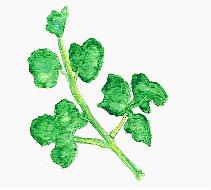Contribute
| Purslane - Coriander |
Usha Palaniswamy Ph.D., M.Ed.
05/20/2004
Introduction
Coriander (Coriandrum sativum, Apiaceae) is native to Asia Minor. It is an essential ingredient in Asian cuisines, frequently used as a garnish and a flavoring agent. The name "coriander" is derived from the Greek word "kopis" which means "bug." The Greeks associated the peculiar odor, rather offensive to some, to that associated with bedbugs. The fresh leaves are referred to as "cilantro" while the seeds used as a spice are called coriander.
Cultivation and Traditional uses
Coriander is extensively grown in India, several parts of Europe, Asia, Morocco, Canada, and South and Western Australia. Coriander thrives best in dry summer and sunny locations. Normally seeds are sown directly in the garden or in containers on a sunny porch or a balcony. Fresh coriander leaves are commonly added to spicy foods to provide additional flavor. Coriander is used to make chutneys, pickles and to flavor rice, meat and vegetable dishes.
The leaves are not suitable to be dried for culinary use. Coriander seeds are also used in whole or ground forms for flavoring purposes. In Asian cultures, coriander is considered to have cooling, stimulant, carminative and digestive properties. Coriander has been documented as a traditional treatment for diabetes in Ayurvedic medicine. In Persian cultures, this plant is believed to have carminative, diuretic and anticonvulsant effects (Zargari, 1369).
Botany
Coriander is a herbaceous plant growing to a height of up to 2.5 ft (0.7 m) with bright green leaves and small white or pale-pink flowers formed in umbel-like clusters. Coriander looks like parsley but the bunches of green coriander can be distinguished in the market for their aroma. Tender leaves are harvested before flowering (bolting) for culinary use. The fruits are almost globular, 3-4 mm (~0.2 in) in diameter, green in color when mature and unripe, turning a yellow-brown when ripe. The fruits consist of two halves (single-seeded mericarps).
Current Use and Health Value
Powdered coriander seeds are used as an important ingredient of curry powders in India, to flavor liqueurs in Russia and Scandinavia, as an important flavoring agent in gin production in Europe. The seeds are also used (both whole and ground) in baking, sausages, pickles, candies, sauces and soups.
Coriander seeds are used as a pickling spice, in seasonings and sausages and also in pastries, buns, cakes and other confectionery. Coriander oil is used to flavor alcoholic beverages, candies, meat, sauces and tobacco. Coriander incorporated into the diet and drinking water demonstrated the presence of antihyperglycemic, insulin-releasing and insulin-like activity (Gray & Flatt, 1999).
Coriander has been reported to have several pharmacological effects such as antifertility (Al-Said et al., 1987), anti-hyperglycemic (Swanston-Flatt et al., 1990, Gray & Flatt, 1999), anti-hyperlipidemic (Chithra & Leelamma, 1997, Chithra & Leelamma, 1999, Weber et al., 1999), anti-oxidant (Chithra & Leelamma, 1997), anti-proliferative (Nakano et al., 1998), hypotensive (Medhin et al., 1986) and digestive stimulant (Platel & Srinivasan, 2000). Coriander leaves are also excellent sources of naturally occurring antioxidant flavanoids (Justesen & Knuthsen, 2001).
References
Al-Said MS, Al-Khamis KI, Islam MW, Parmar NS, Tariq M, Ageel AM. 1987. Post-coital antifertility activity of the seeds of Coriandrum sativum in rats. J Ethnopharmacol 21:165-173.
Chithra V, Leelamma S. 1997. Hypolipidemic effect of coriander seeds ( Coriandrum sativum): mechanism of action. Plant Foods Hum Nutr 51:167-172.
Chithra V, Leelamma S. 1999. Coriandrum sativum changes the levels of lipid peroxides and activity of antioxidant enzymes in experimental animals. Indian J Biochem Biophys 36:59-61.
Gray AM, Flatt PR. 1999. Insulin-releasing and insulin-like activity of the traditional anti-diebetic plant Coriandrum sativum(coriander). Br J Nutr 81:203-209.
Justesen U, Knuthsen P. 2001. Composition of flavonoids in fresh herbs and calculation of flavonoid intake by use of herbs in traditional Danish dishes, Food Chemistry 73(2):245-250.
Medhin DG, Hadhozy P, Bakos P, Verzar-Perti G. 1986. Hypotensive effects of Lupinus termis and Coriandrum sativum in anesthetized rats: preliminary study. Acta Pharm Hung 56: 59-63.
Nakano Y, Matsunaga H, Saita T, Mori M, Katano M, Okabe H. 1998. Antiproliferative constituents in Umbelliferae plants II. Screening for polyacetylenes in some Umbelliferae plants, and isolation of panaxynol and falcarindiol from the root of Heracleum Moellendorffii. Biol Pharm Bull. 21:257-261.
Platel K, Srinivasan K. 2000. Stimulatory influence of select spices on bile secretion in rats. Nutrition Research 20(10):1493-1503.
Swanston-Flatt SK, Day C, Bailey CJ, Flatt PR. 1990. Traditional plant treatments for diabetes: studies in normal and streptozotocin diabetic mice. Diabetologia 33:462-464.
Weber N, Schöwiese S, Klein E, Mukherjee KD. 1999. Adipose tissue triacylglycerols of rats are modulated differently by dietary isomeric octadecenoic acids from coriander oil and high oleic sunflower oil. J Nutr 129: 2206-2211.
Zargari A. 1990. Medicinal Plants. Tehran University Press, Tehran, 580-590.
You may also access this article through our web-site http://www.lokvani.com/

